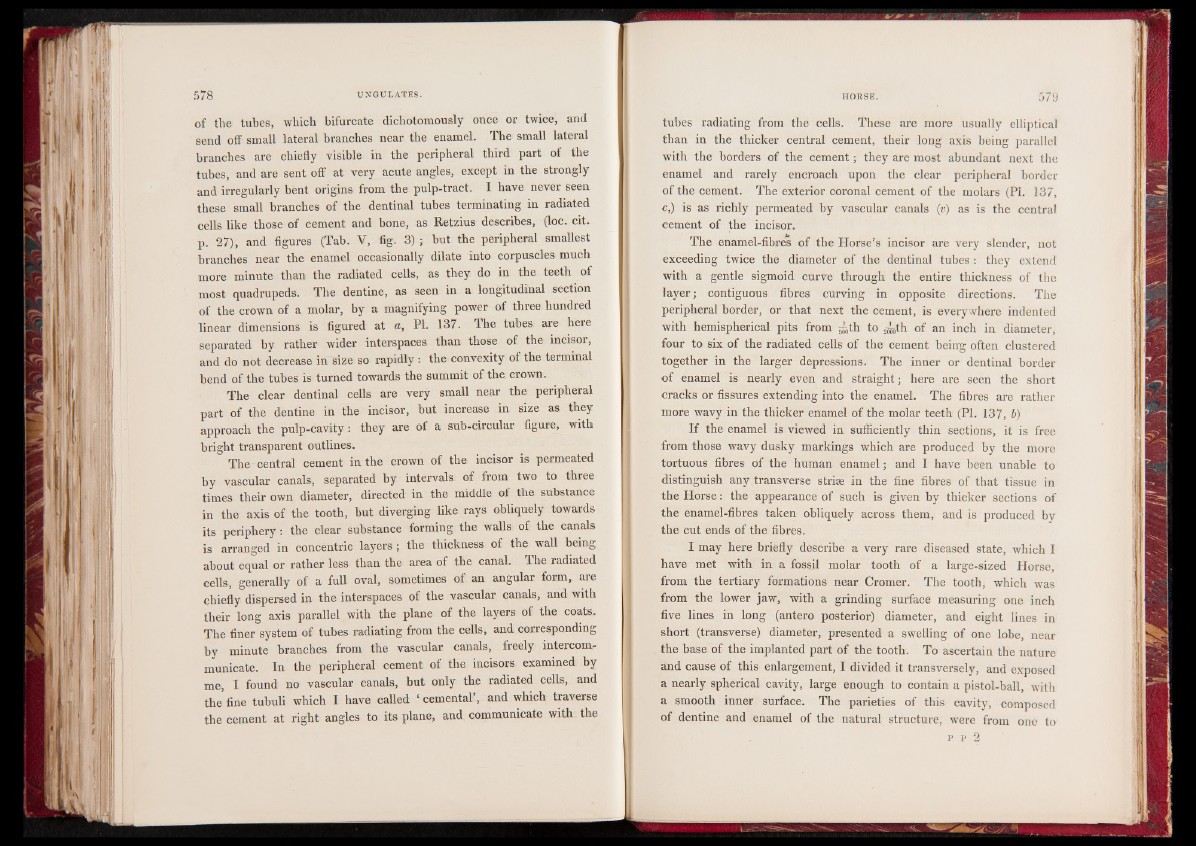
of the tubes, which bifurcate dichotomously once or twice, and
send off small lateral branches near the enamel. The small lateral
branches are chiefly -visible in the peripheral third part of the
tubes, and are sent off at very acute angles, except in the strongly
and irregularly bent origins from the pulp-tract. I have never seen
these small branches of the dentinal tubes terminating in radiated
cells like those of cement and bone, as Retzius describes, (loc. cit.
p. 27), and figures (Tab. V, fig. 3) ; but the peripheral smallest
branches near the enamel occasionally dilate into corpuscles much
more minute than the radiated cells, as they do in the teeth of
most quadrupeds. The dentine, as seen in a longitudinal section
of the crown of a molar, by a magnifying power of three hundred
linear dimensions is figured at a, PI. 137. The tubes are here
separated by rather wider interspaces than those of the incisor,
and do not decrease in size so rapidly : the convexity of the terminal
bend of the tubes is turned towards the summit of the crown.
The clear dentinal cells are very small near the peripheral
part of the dentine in the incisor, but increase in size as they
approach the pulp-cavity : they are of a sub-circular figure, with
bright transparent outlines.
The central cement in the crown of the incisor is permeated
by vascular canals, separated by intervals of from two to three
times their own diameter, directed in the middle of the substance
in the axis of the tooth, but diverging like rays obliquely towards
its periphery: the clear substance forming the walls of the canals
is arranged in concentric layers ; the thickness of the wall being
about equal or rather less than the area of the canal. The radiated
cells, generally of a full oval, sometimes of an angular form, are
chiefly dispersed in the interspaces of the vascular canals, and with
their long axis parallel with the plane of the layers of the coats.
The finer system of tubes radiating from the cells, and corresponding
bv minute branches from the vascular canals, freely intercommunicate.
In the peripheral cement of the incisors examined by
me, I found no vascular canals, but only tbe radiated cells, and
the fine tubuli which I have called ‘ cemental’, and which traverse
the cement at right angles to its plane, and communicate with the
tubes radiating from the cells. These are more usually elliptical
than in the thicker central cement, their long axis being parallel
with the borders of the cement; they are most abundant next the
enamel and rarely encroach upon the clear peripheral border
of the cement. The exterior coronal cement of the molars (PL 137,
c,) is as richly permeated by vascular canals (v) as is the central
cement of the incisor.
The enamel-fibres of the Horse’s incisor are very slender, not
exceeding twice the diameter of the dentinal tubes : they extend
with a gentle sigmoid curve through the entire thickness of the
layer; contiguous fibres curving in opposite directions. The
peripheral border, or that next the cement, is everywhere indented
with hemispherical pits from ^ th to 2it h of an inch in diameter,
four to six of the radiated cells of the cement being often clustered
together in the larger depressions. The inner or dentinal border
of enamel is nearly even and straight; here are seen the short
cracks or fissures extending into the enamel. The fibres are rather
more wavy in the thicker enamel of the molar teeth (PI. 137, b)
If the enamel is viewed in sufficiently thin sections, it is free
from those wavy dusky markings which are produced by the more
tortuous fibres of the human enamel; and I have been unable to
distinguish any transverse striae in the fine fibres of that tissue in
the Horse: the appearance of such is given by thicker sections of
the enamel-fibres taken obliquely across them, and is produced by
the cut ends of the fibres.
I may here briefly describe a very rare diseased state, which I
have met with in a fossil molar tooth of a large-sized Horse,
from the tertiary formations near Cromer. The tooth, which was
from the lower jaw, with a grinding surface measuring one inch
five lines in long (antero posterior) diameter, and eight lines in
short (transverse) diameter, presented a swelling of one lobe, near
the base of the implanted part of the tooth. To ascertain the nature
and cause of this enlargement, I divided it transversely, and exposed
a nearly spherical cavity, large enough to contain a pistol-hall, with
a smooth inner surface. The parieties of this cavity, composed
of dentine and enamel of the natural structure, were from one to